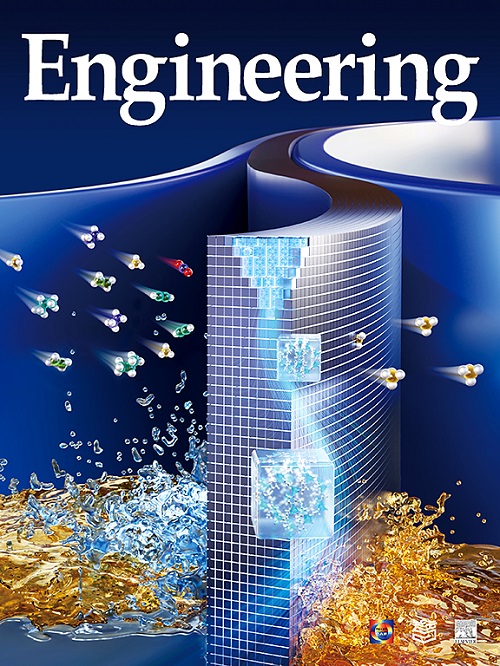Cyclic Construction and Load Redistribution in Steel–Ultra-High-Performance Concrete Composite Arch Using Optimized Sliding Connectors
IF 10.1
1区 工程技术
Q1 ENGINEERING, MULTIDISCIPLINARY
引用次数: 0
Abstract
The proposed steel–ultra-high-performance concrete composite truss (SUCT) arch bridge addresses three major technical problems of conventional arch bridges and extends the span to 600–1000 m. An intelligent cyclic construction method and an automated sliding connector are proposed for the SUCT arch ring to reduce construction costs and mitigate stress superposition. This method involves multiple closures of the arch ring from inside to outside. This paper introduces the cyclic construction method, compares it with existing methods, and investigates the mechanical behavior and load distribution of the arch ring through experimental analysis in both slidable and locked states of the sliding connectors. An optimized design for sliding connectors was also developed. The results indicate that the cyclic construction method offers distinct advantages over traditional techniques, ensuring the construction feasibility of SUCT arch bridges. The sliding connectors released most vertical shear forces, and the corresponding bending moments were transferred to the inner arch. Consequently, approximately 10% of the load was transferred to the inner arch, representing approximately 20% of the load in the locked state. However, approximately 25.5% of the negative bending moments were transferred to the inner arch in spring conditions. During the arch ring’s asymmetric loading process, the inner arch’s left spring cracked and crushed before the outer arch due to stress superposition. By optimizing the sliding surface to a vertical orientation (0°) and lubricating the sliding plate and chute, negative bending moments and vertical loads were effectively isolated from the inner arch, eliminating stress superposition and significantly enhancing crack resistance and load-bearing capacity. With the optimized design, the load borne by the innermost arch was reduced to 48% and 85% compared to the non-sliding connector scheme and the original design. Furthermore, the load distribution across all truss arch rows was uniform. These findings advance both the theoretical understanding and practical implementation of innovative arch bridge construction, offering insights for the infrastructure sector.基于优化滑动连接件的钢-超高性能混凝土组合拱循环施工与荷载再分配
本文提出的钢-超高性能混凝土组合桁架(sut)拱桥解决了传统拱桥的三大技术难题,并将跨度扩大到600 - 1000m。为降低施工成本和减轻应力叠加,提出了sut拱环的智能循环施工方法和自动滑动连接件。这种方法包括从内到外的多个拱形环闭合。本文介绍了循环施工方法,并与现有方法进行了比较,通过对滑动连接件在滑动状态和锁定状态下的力学行为和荷载分布进行了实验分析。对滑动接插件进行了优化设计。结果表明,循环施工方法相对于传统施工方法具有明显优势,保证了sut拱桥施工的可行性。滑动连接件释放了大部分竖向剪力,并将相应的弯矩传递给了内拱。因此,大约10%的荷载被转移到内拱,大约20%的荷载处于锁定状态。然而,在弹簧条件下,大约25.5%的负弯矩传递给了内拱。在拱环非对称加载过程中,由于应力叠加,内拱左弹簧先于外拱开裂破碎。通过将滑面优化为垂直方向(0°),并对滑板和溜槽进行润滑,有效地隔离了内拱的负弯矩和竖向荷载,消除了应力叠加,显著提高了抗裂能力和承载能力。优化设计后,最内层拱所承受的荷载比非滑动连接方案和原设计分别降低48%和85%。此外,所有桁架拱排之间的荷载分布均匀。这些发现促进了对创新拱桥施工的理论认识和实践实施,为基础设施部门提供了见解。
本文章由计算机程序翻译,如有差异,请以英文原文为准。
求助全文
约1分钟内获得全文
求助全文
来源期刊

Engineering
Environmental Science-Environmental Engineering
自引率
1.60%
发文量
335
审稿时长
35 days
期刊介绍:
Engineering, an international open-access journal initiated by the Chinese Academy of Engineering (CAE) in 2015, serves as a distinguished platform for disseminating cutting-edge advancements in engineering R&D, sharing major research outputs, and highlighting key achievements worldwide. The journal's objectives encompass reporting progress in engineering science, fostering discussions on hot topics, addressing areas of interest, challenges, and prospects in engineering development, while considering human and environmental well-being and ethics in engineering. It aims to inspire breakthroughs and innovations with profound economic and social significance, propelling them to advanced international standards and transforming them into a new productive force. Ultimately, this endeavor seeks to bring about positive changes globally, benefit humanity, and shape a new future.
 求助内容:
求助内容: 应助结果提醒方式:
应助结果提醒方式:


